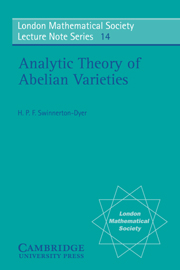Summary
For fixed n > 0 let Cn denote n-dimensional complex space and R2n the underlying 2n-dimensional real space. Let Λ be a lattice in R2n – that is, a free abelian group on 2n generators which spans R2n; thus with the induced topology Λ is discrete and T = R2n/Λ is compact. T has a natural structure as a complex manifold, which we recognize by writing it as T = Cn/Λ, and with this structure it is called a complex torus. The most interesting case is when there are sufficiently many meromorphic functions on T, in a sense that will be made precise in Chapter II; in this case T is called an abelian manifold, and is usually denoted by A. Thus from one point of view the study of abelian manifolds is essentially the study of meromorphic functions of n complex variables having 2n independent periods. Thus it forms a natural generalization of the theory of elliptic functions – that is, of doubly periodic functions of one complex variable, Historically, the other parent of the subject was the study of compact Riemann surfaces; indeed the term ‘abelian manifolds’ comes from the connection with Abel's theorem.
A compact Riemann surface is just another way of describing a non-singular algebraic curve; and this already gives a connection between algebraic geometry and abelian manifolds. This connection was much strengthened by Lefschetz and the great Italian geometers, who showed that abelian manifolds are an important tool in the problem of classifying non-singular varieties.
- Type
- Chapter
- Information
- Analytic Theory of Abelian Varieties , pp. v - viiiPublisher: Cambridge University PressPrint publication year: 1974

